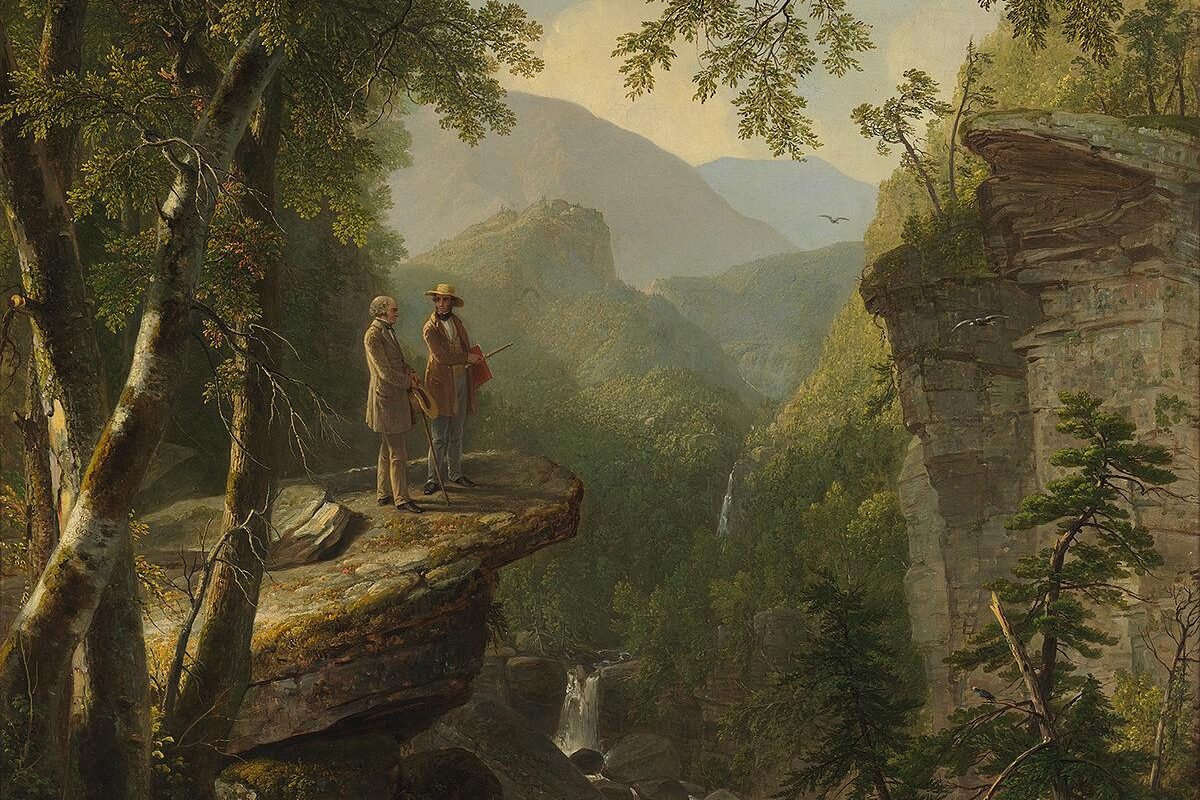Above image: Asher B. Durand, Kindred Spirits, 1849, oil on canvas, Crystal Bridges Museum of American Art, Bentonville, Arkansas © 2006 Board of Trustees, National Gallery of Art, Washington D.C.
I.
“This time, like all times, is a very good one, if we but know what to do with it.” – Ralph Waldo Emerson
Time hasn’t changed. It remains the same scarce resource none of us can renew.
Time is a gift, one we can not exchange or cash in for more. Whatever the world outside may look like, the choice is before you daily – where will you spend your time?
The ancient Romans had a practice called memento mori, which means, “Remember you must die.” Each of us will come to the end of our time here on Earth, and we don’t know exactly when. This isn’t meant to be an exercise in fear or morbidity, but a realization that death is a part of life. When we grasp this truth, we consider how we spend our time a bit more thoughtfully. Some of us have more time to go than we’ve yet lived; others are winding into their twilight years. The number doesn’t matter so much as realizing there is a number. There will be an end, and at that point it’s too late to try to make your time count.
Today is the day. Choose today to live alive to your values, to embody the person you want to be.
II.
Ralph Waldo Emerson was speaking to a restless nation. The United States were simmering with conflict and buzzing with the recent success of the railroad and Industrial Revolution.
The mid-1800’s saw a nation dealing with the upheaval of social convention and finding footing to move forward. Attitudes shifted away from authoritarian church doctrine toward Enlightenment ideals of rationalism and humanism. Tradition was questioned in the light of modern science and logic. Charles Darwin’s On the Origin of Species would be published in 1859, and draw a stark line between creationism and an empirical account of natural history. Tradition, in some corners, was being revered and preserved for its own sake. The abolitionist cause was gaining traction against the institution of slavery, escalating tensions which would lead to war. The United States were barreling toward conflict.
In the midst of this discord, Emerson emerges as a voice of optimism and self-reliance. While tradition is being dogmatically preserved by one group, and another champions the importance of consistency in Enlightenment thinking (which Emerson addresses in its own essay), Emerson encourages his readers to contemplate truth. Find what is true; not what has been traditionally named truth, nor what others have told you is truth. Find the truth, and live in light of it.
Speaking in 1837 at Harvard, Emerson cautions against the temptation to idealize the past instead of realizing the opportunities at our fingertips. Learning from the past is prudent, but becoming enraptured by it and trapped within its confines only destines us for failure. We have the ability to create our own futures, if we will accept the work which comes along with it. The country was between major cultural events, the Enlightenment and the Civil War, with many looking backward, pining for the “good old days.”
“This time, like all times, is a very good one, if we but know what to do with it.” – Emerson
With his signature optimism, Emerson rhetorically asks why the current age should not be considered the finest age, seeing as his audience have the benefit of learning from history along with emerging technology to improve the ails of the age. Why should the time of progress unfolding before them not be considered the best time to be alive? Instead of looking backward, why not set our gaze forward, and embrace the possibilities our current age offers?
What we focus on is what we will find. If we set our attention on another age, where everything, to our minds at least was better, we forfeit our ability to affect change progress in our present time. We cannot focus on the past and develop forward thinking at the same time. Creating a better future depends on our dealing with reality as it is today, not wishful thinking or idealized versions of history.
III.
One and one half centuries after Emerson’s American Scholar address, we find ourselves in the middle of an Information Age. There are more books, articles, and movies produced in a year than any of us could work through in a lifetime. Marshall McLuhan characterized this reality as an age of “electric speed,” referencing the fact information and technology now travel as quickly as an electric current can carry it. We have information always available at our fingertips, at a moment’s notice. Our struggle isn’t in finding ways to pass the time, but in making use of our time.
Yet, we also find ourselves in an in-between moment. We are in a pandemic. A dangerous virus is currently making its way through the nations. This year has upended our expectations and perceptions of time. We went from seemingly not having enough time, to suddenly having too much of it.
Author Seth Godin recently observed that these two seeming contradictions are always true; we are running out of time and we have too much time on our hands. Time is our greatest resource and our most wasted commodity. We alternate between trying to make time stop and willing it to hurry along, a curious quintessentially human trait.
What if we shifted our mindset from spending time to using time? How would our actions change if we thought of time as a tool to use for building the life we desire?
To paraphrase Emerson, today is a great day, if we know what to do with it.
Using time means aligning our activities with our values. Using time means building purpose into each day. It means outlining what gets done in a day, whether it’s putting out meaningful work or sitting down to be present with your loved ones. It’s putting life into your hours instead of slowly watch time click by over the course of a day.
We still have the same twenty-four hours as ever. Being sequestered in our homes may have revealed just how long twenty-four hours can be. Without commutes or traffic or errands to run, the day can suddenly feel endless. What then? What do we do when time seems to be standing still? What should we do while we wait?
IV.
“What shall I do while I wait?”
This is a deceptive question. It implies there is a distinction between our mundane today and sometime in the future when “real life” will return. It reminds me of my years in high school and college, preparing with anticipation for the day my “real life” would begin. All the classes and homework and sports competitions and volunteering; all of it intended to “prepare” students for life. The irony is, of course, all those years of preparation were just as real as any year to follow. Every aspect of our days are “real life.”
It’s tempting to think of this year as one big rain delay. We’ll just wait for the storm to clear up, then go on with our schedules. The sun will come out and we can get on with life. Time doesn’t wait, though, and we can’t afford to either. Life doesn’t have rehearsals or time-outs. Time marches on, impervious to our demands to slow down or hurry up.
The in-between moments are real life. In between the great big, scrapbook moments are where life happens; the days spent chatting with husbands or wives, making daily progress, and simply living. Those are the moments to fill with intention. Those small moments where we lose track of time is life at its sweetest.
We create more time by spending time on those activities which make time fly by. It’s having a great conversation with friends, by working on a meaningful project, by catching up with loved ones, or by reading a beautiful book. Instead of waiting for the big moments, put your time where you want it to go.
Wherever we find ourselves in our chronological age, this Information age, or our current moment of uncertainty, the opportunity is the same – focus on your purpose and use that purpose and intention to determine where your time goes.
Today is a great day, if you know how to use it.




